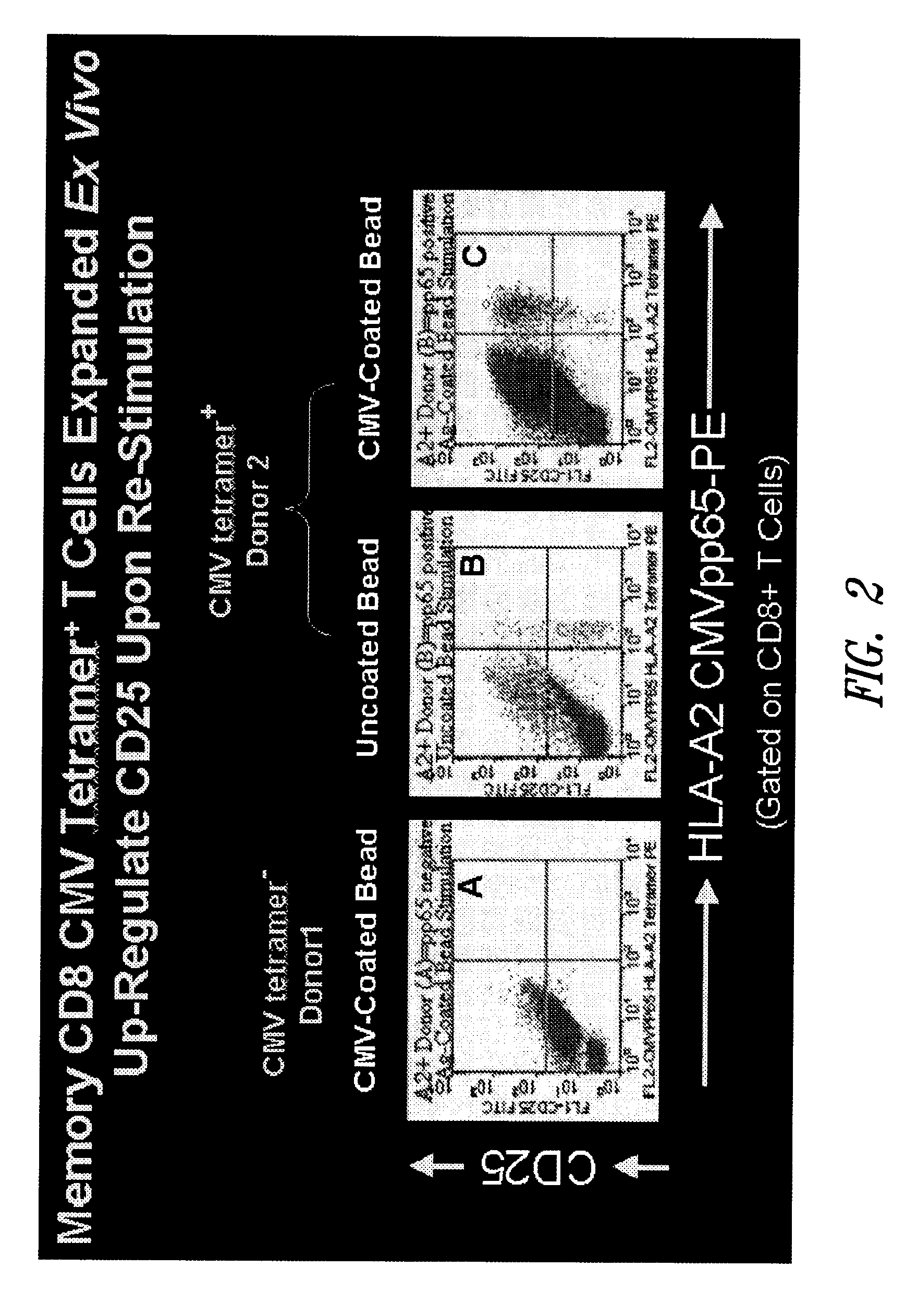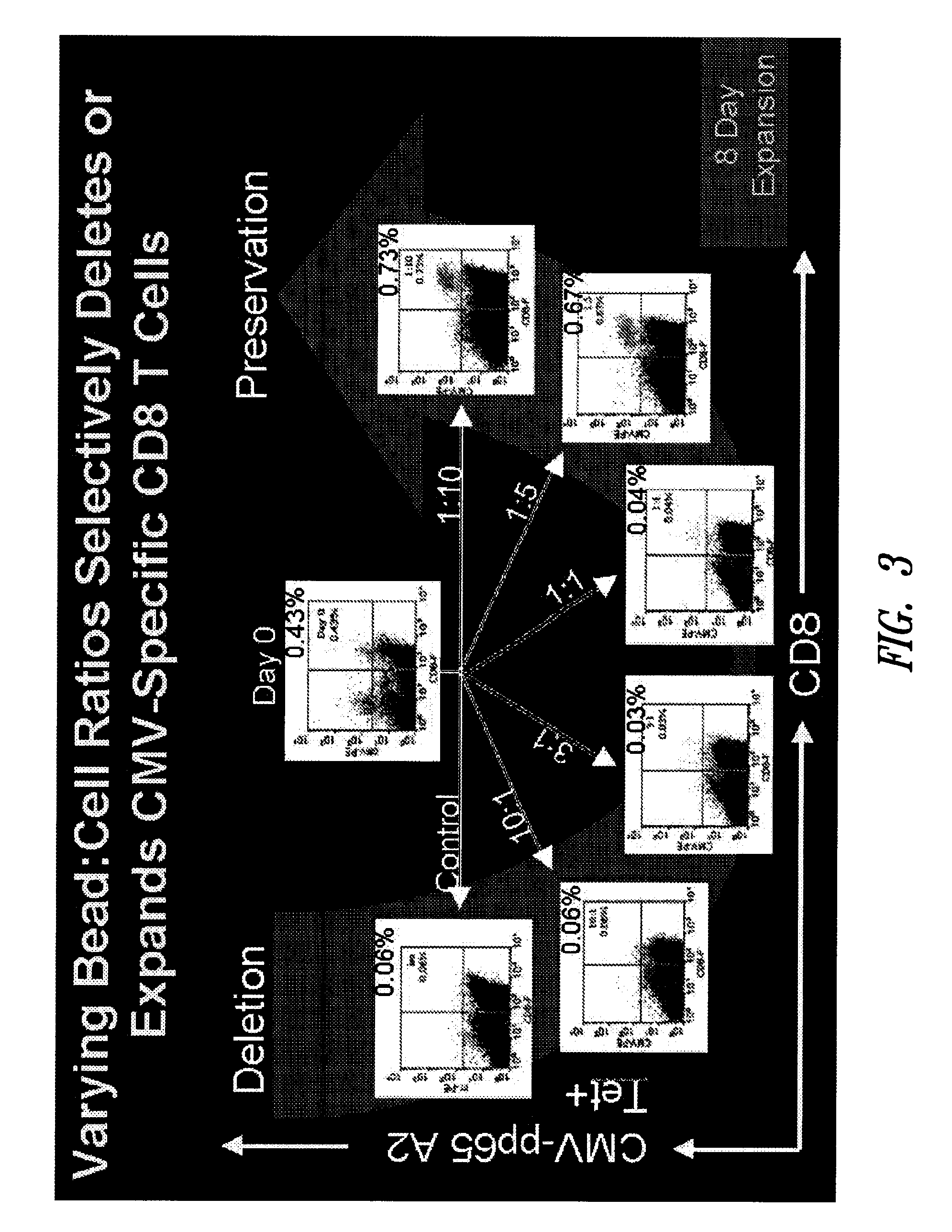Generation and isolation of antigen-specific T cells
a technology of antigen-specific t cells and t cells, which is applied in the field of generating, isolating, and expanding antigen-specific t cells, can solve the problems of reducing the number of cancer cells, requiring labor intensive and expensive cloning, and affecting the survival rate of t cells during long-term culture. it can reduce the presence of cancer cells
- Summary
- Abstract
- Description
- Claims
- Application Information
AI Technical Summary
Benefits of technology
Problems solved by technology
Method used
Image
Examples
example 1
CMV Antigen Coated Beads Activate and Facilitate Isolation of Antigen-Specific T Cells
[0141]In this experiment, cytomegalovirus (CMV)-coated beads were used to activate and isolate antigen-specific T cells.
[0142]CMV lysate prepared using standard techniques was mixed at room temperature for 1-2 hours with Dynabead M-450 while rotating. Beads were then washed once, and added to PBMC. Within hours, the beads were phagocytosed in the APC. Within 72 hours, CMVpp65-HLA-A2 tetramers detected CD25-high (activated) T cell specific for CMV pp65. Magnetic selection of the bead-loaded APC with the associated antigen-specific T cells was carried out at day 5, thereby enriching for CMV-specific T cells. As shown in FIG. 1, following magnetic separation, CMV-specific T cells were still tightly associated with bead-loaded APC. It should be noted that magnetic separation can be carried out anywhere from about day 1 to about day 10.
example 2
Memory CD8 CMV Tetramer+ T Cells Expanded Ex Vivo Up-Regulate CD25 Upon Re-Stimulation
[0143]In this example, antigen-coated beads were used to activate CMV-specific CD8+ T cells ex vivo.
[0144]PBMC from CMV pp65 tetramer-positive and tetramer-negative donors were stimulated with paramagnetic Dynal M-450 beads coated with CMV lysate. As controls, CMV pp65 tetramer-negative PBMC were cultured with CMV-lysate coated beads (FIG. 2, panel A), CMV pp65 tetramer-positive PBMC were cultured with “naked” beads (no CMV antigen) (FIG. 2, panel B). CMV pp65 tetramer-positive PBMC were cultured with CMV-lysate coated beads (FIG. 2, panel C). Following stimulation, activation of CMV-specific T cells was measured on Day 10 by CMV pp65 HLA-A2 tetramer stain and CD25 expression as an indicator of activation. As shown in FIG. 2, up-regulation of CD25 was observed in memory CD8 CMV tetramer+ T cells expanded ex vivo using antigen-coated beads.
[0145]Antigen-coated beads can be used to activate and stimu...
example 3
Varying Bead:Cell Ratios can Selectively Expand or Delete Memory CD8 T Cells
[0146]This example shows that the bead:cell ratio can have a profound effect on expansion of different populations of T cells. In particular, a high bead:cell ratio (3:1-10:1, 20:1 and higher) tends to induce death in antigen-specific T cells while a lower bead:cell ratio (1:1-1:10, 1:20, 1:30, 1:40, 1:50 or lower) leads to expansion of antigen-specific T cells. Further, the data described below show that lower bead:cell ratios lead to improved cell expansion in polyclonal cell populations as well. Thus, this example shows that lower bead:cell ratios improve overall cell expansion.
[0147]Cells were prepared and stimulated using the XCELLERATE I™ process essentially as described in U.S. patent application Ser. No. 10 / 187,467 filed Jun. 28, 2002. Briefly, in this process, the XCELLERATED™ T-cells are manufactured from a peripheral blood mononuclear cell (PBMC) apheresis product. After collection from the patien...
PUM
 Login to View More
Login to View More Abstract
Description
Claims
Application Information
 Login to View More
Login to View More - R&D
- Intellectual Property
- Life Sciences
- Materials
- Tech Scout
- Unparalleled Data Quality
- Higher Quality Content
- 60% Fewer Hallucinations
Browse by: Latest US Patents, China's latest patents, Technical Efficacy Thesaurus, Application Domain, Technology Topic, Popular Technical Reports.
© 2025 PatSnap. All rights reserved.Legal|Privacy policy|Modern Slavery Act Transparency Statement|Sitemap|About US| Contact US: help@patsnap.com



